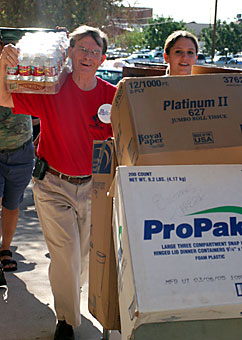 |
|
Cassandra Tomlin/Arizona Daily Wildcat
|
UA President Peter Likins helps a freshman move into Coronado Residence Hall Thursday morning. Every residence hall on campus is full to capacity this year.
|
|
|
By Mika Mandelbaum
Arizona Daily Wildcat
August 22, 2005
Print this
With about 6,000 students living on campus this year, residence halls are packed with no vacancies, forcing several new students to share rooms with resident assistants or make alternative, off-campus arrangements.
"Living on campus has just become much more popular," said Jim Van Arsdel, residence life director. "This year we had so many students to accommodate."
Last year, the residence halls opened with a few vacancies, but this year more than 200 students were put on a waiting list for on-campus housing. About half of the male students on the list were eventually assigned housing, but residence life was not able to work down the women's list at all, Van Arsdel said.
Those students were told to make alternate housing arrangements.
"We started turning people away by mid summer," he said.
In past years, residence life put students in hotels and converted some study lounges into temporary housing to try to accommodate everyone.
"We were really damaging their freshman experience," said President Peter Likins, as he helped freshman students move into their rooms Thursday morning.
Helping freshmen move in is an annual tradition Likins brought to UA from his previous position as president of Lehigh University in Pennsylvania.
"It makes (the students) realize that it's a top-to-bottom, welcoming kind of place when they see the president sweating in a T-shirt," Likins said.
This year, however, Van Arsdel said neither hotels nor study lounges were considered as ways to solve the housing shortage.
As a result, there are some students who are assigned to temporary spaces in rooms with resident assistants, who typically live alone.
So far, all but one of the female resident assistants in Arizona-Sonora residence hall, 940 E. Fifth St., have been assigned freshman roommates.
"I don't mind having a roommate at all. None of us do, but I feel sorry for the students," said Lana Abu-Shaheen, a management information systems senior and resident assistant for Arizona-Sonora. "They just have to understand that it's a temporary thing, two weeks at most."
This is Abu-Shaheen's second year as a resident assistant, and both times she started the year with a freshman roommate.
"It's really fun and you get to know your residents a lot better and build that relationship with them," she said.
Van Arsdel said part of the housing problem stems from the absence of one residence hall on campus this year.
Maricopa Hall, 1031 E. North Campus Drive, and its 111 rooms are closed for the year. A plumbing project in the hall was postponed when residence life did not get legislative approval to finance it. The hall is scheduled to reopen by fall 2006, Van Arsdel said.
Residence life is continually trying to improve all of the residence halls, but the students will always have their favorites, Van Arsdel said.
The three newest residence halls, Villa Del Puente, Posada San Pedro and Pueblo De La Cienega, are very popular among students. La Paz and Pima also remain among the most popular residence halls, Van Arsdel said.
Yet Coronado residence hall consistently attracts the most students year after year, he said.
Coronado has suite-style bathrooms, allowing what some may consider more convenience and privacy. It has also historically housed a high percentage of students in the greek system, so there is word of mouth that Coronado is the social place to be, Van Arsdel said.
"They become self-sustaining over time because the reputations they build become more important than anything else," he said.
Students will even pay more money to live in a reputable hall. The top-tier dorms, like Coronado and La Paz, cost $500 more per year than the less popular dorms. Prices are determined by recommendations each year from the Residence Hall Association, Van Arsdel said.
Regardless of price or popularity, every residence hall fills up because students and parents appreciate the social, community atmosphere and all-around convenience.
"It's a sense of support personally and academically," said Alejandro Leano, an aerospace engineering junior. "And lifestyle-wise, you don't have to worry about bills and furniture."
In the meantime, Residence Life is doing the best it can to accommodate everyone.
